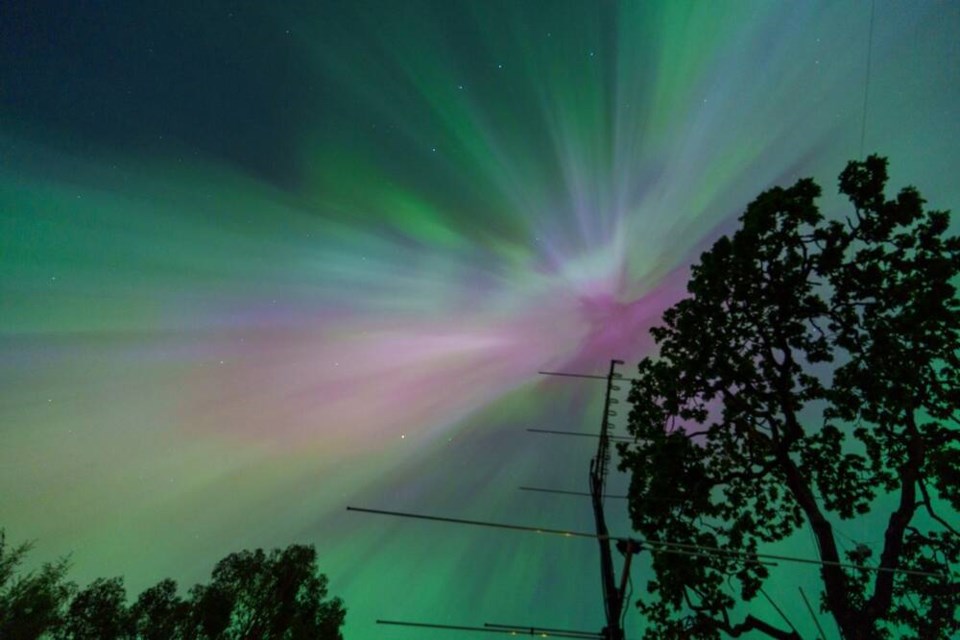People flocked to bodies of water and other viewpoints on Friday night and early Saturday to catch a rare glimpse of the northern lights over Vancouver Island.
Melissa Perkins said she nearly got tears in her eyes when she saw the aurora borealis dance across the sky above San Juan Island from a rocky beach in Saanich.
“It’s magical. So magical.”
Her partner, Jon, who was standing next to her, said while he remembers seeing the northern lights in Victoria about 15 years ago, they weren’t as visible.
Perkins, who is originally from California, said that seeing the northern lights was one of the items on her bucket list but she never imagined that she would be able to see them from Victoria.
The capital region experienced a flurry of activity as people headed to parks, bodies of water, and the shoreline for a better view.
“I’ve never been out in Victoria this late where people are like, whipping around Cadboro Bay [in their cars],” she said.
Ben Campbell said he went searching for the lights with a friend after hearing that the northern lights might be visible and found “quite the show” at Jordan River for about an hour after 10:30 p.m.
Some roads experienced traffic jams at midnight.
Motorists inched to a crawl as they squeezed past a line of parked cars on Beach Drive near Cattle Point.
Another viewpoint, Mount Tolmie, was similarly packed with skygazers.
Social media platforms were awash with people from across Vancouver Island sharing their photo of the lights.
Cheryl Wright said she was able to catch a glimpse of the lights from the backyard of her home in Victoria’s Gonzales neighbourhood.
“The purple cross-striations were interesting,” she said in an email. Wright said that her husband’s ham radio’s shortwaves were interrupted due to the aurora.
The increased visibility of the aurora borealis across much of sa╣·╝╩┤л├╜ was due to an exceptionally strong solar storm that hit the planet early Saturday.
Visibility of the northern lights was expected to continue for Islanders Saturday night and early Sunday.
There were preliminary reports of power grid irregularities, degradation of high-frequency communications and global positioning systems.
The U.S. National Oceanic and Atomospheric Administration predicted that strong flares will continue through at least Sunday.
On Saturday morning, SpaceX’s Starlink satellite internet service said on its website that service had been degraded and its team was investigating. CEO Elon Musk wrote on the social platform X overnight that its satellites were “under a lot of pressure, but holding up so far.”
Brilliant purple, green, yellow and pink hues of the northern lights were reported worldwide, with sightings in Germany, Switzerland, China, England, Spain and elsewhere.
NOAA issued a rare severe geomagnetic storm warning when a solar outburst reached Earth on Friday afternoon, hours sooner than anticipated. The agency alerted operators of power plants and orbiting spacecraft to take precautions.
“For most people here on planet Earth, they won’t have to do anything,” said Rob Steenburgh, a scientist with NOAA’s Space Weather Prediction Center. “That’s really the gift from space weather: the aurora,” Steenburgh said. He and his colleagues said the best views may come from phone cameras, which are better at capturing light than the naked eye.
Snap a picture of the sky, and “there might be actually a nice little treat there for you,” said Mike Bettwy, operations chief for the prediction centre.
Even when the storm is over, signals between GPS satellites and ground receivers could be scrambled or lost, according to NOAA. But there are so many navigation satellites that any outages should not last long, Steenburgh noted.
The sun has produced strong solar flares since Wednesday, resulting in at least seven outbursts of plasma. Each eruption, known as a coronal mass ejection, can contain billions of tons of plasma and magnetic field from the sun’s outer atmosphere, or corona.
The flares seem to be associated with a sunspot that is 16 times the diameter of Earth, NOAA said. It is all part of the solar activity ramping up as the sun approaches the peak of its 11-year cycle.
Did you take a photo of the northern lights from Vancouver Island on Friday night? Send your pictures to [email protected] with the words “northern lights” in the subject line. Let us know where and when the photo was taken and the name of the photographer. We’ll share some of our favourites in the paper and online.



